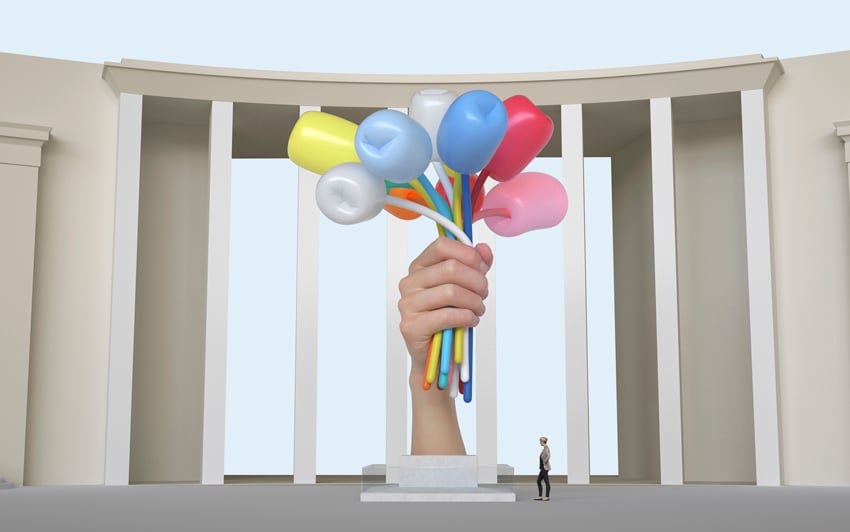Art World
Jeff Koons’s Production Company Defends His Controversial Paris Memorial Against Fierce Backlash
The company says the bouquet "cannot become a symbol of discord!”

The company says the bouquet "cannot become a symbol of discord!”

Taylor Dafoe

Last week, more than two-dozen figures in the French art world signed an open letter urging Paris to reject Jeff Koons’s Bouquet of Tulips, a larger-than-life sculpture planned as a memorial to the 2015 terrorist attacks at Paris’s Bataclan concert hall. Now, the company responsible for the project has issued a response defending the work against the backlash.
In an email statement sent out on Monday, French art production house Noirmontartproduction said it aimed to “re-establish its original concept and the precise factual chronology of its development.”
The email describes the genesis of the divisive work—which has been called everything from “a poisoned chalice” to “an act of product placement” by critics. Koons, the company recounts, was invited to undertake the project by the former US ambassador to France, Jane Hartley. The artist visited many locations in the city before settling on the site between the city’s Museum of Modern Art and the Palais de Tokyo, chosen for its “symbolic resonance.”
Koons altered the final dimensions of the sculpture so as to “respectfully comply its proportions with the classical surrounding architecture” and the mayor of Paris approved the installation. In response to complaints about the cost of the work, the company notes that the project was funded entirely by gifts from French-American donors (via a fundraising campaign) and that all proceeds from the copyright on the work will be given to the families of the victims of the attacks.
The statement concludes dramatically: “Conceived as a gesture of friendship and union, the Bouquet of Tulips of Jeff Koons cannot become a symbol of discord!”
Read an edited excerpt of the email below.
Shortly after the attacks of November 2015, being deeply touched by the huge number of messages from American citizens expressing their support and friendship to the Parisians and the French people, Jane Hartley proposed to Jeff Koons to create an artwork that would be offered to the city of Paris in homage to the victims of the attacks. In great love with France and very moved by the tragic events, the artist immediately accepted and imagined a new work, a monumental unique piece, created specifically to embody this gesture of generosity: Bouquet of Tulips.
The work is not imagined as a memorial but as a message of hope to deliver to the present and future generations: “Created as a symbol of remembrance, optimism and healing, Bouquet of Tulips symbolizes the act of offering, represented by the outstretched hand holding the brightly colored flowers.” The artist rather wished to express the painful context of the attacks into a symbolic work, both in its iconography and in its aesthetic experience. A dozen has symbolized plenitude since the Antiquity. Unlike the tradition, the Bouquet of Tulips consists of 11 flowers only; the missing 12th one evokes here the absence, the victims lost in the attacks. The appearance of the work sticks to this reality with a very “true” aspect, unlike the shiny and reflective surfaces of some famous Koons’ creations. The skin of the hand, with its texture and all its details, seems real. The “tulips” are balloon tulips with vivid colors, carrying a philosophical meaning in the physicality of their membrane.
The choice of the Palais de Tokyo site resulted from a long reflection, run from spring through fall 2016. The installation place of a monumental and durable artwork must be relevant to the symbolism of the work. The Statue of Liberty was installed at the entrance of New York Harbor, next to Ellis Island, that represented the gate to the New World for the XIXth century immigrants. Like so, the installation location for Bouquet of Tulips in Paris had to be at once significant, carrying cultural and human values, and not official or political ones, exclusive, as regards the homage it embodies, and open, considering all the numerous artworks already installed in Paris public space.
In June 2016, in addition to the Palais de Tokyo, the Marie de Paris proposed to Jeff Koons several other locations. The artist came to see them all in July 2016, except those that had been immediately excluded because they entered into the perspective of Paris emblematic monuments.
When focusing on our research on the relevance of the location, the Palais de Tokyo is a proposition that we made personally and which was included by the mayor in her proposal to the artist as it embodies the whole symbolism of the project.
The Mayor of Paris, sensitive to the significant relevance of the location, had given her approval to install Bouquet of Tulips there. The artist then redefined the final dimensions of the sculpture to respectfully comply its proportions with the classical surrounding architecture, and has imagined a travertine pedestal, in a stone similar to the columns of the peristyle.
As this site is not “registered” but simply “listed” on the inventory of the Historical Monuments, the direction of the Architectes des Bâtiments de France was consulted by the services of the City of Paris and has given an oral approval for this implantation. The written formalization of this authorization is to occur when filing the final license. Studies were conducted by the Direction de la Voirie and confirmed the feasibility of the installation.
May these clarifications allow today everyone to form his own opinion based on factual truths and not on simple clichés. The debate shall be expressed serenely and avoid unjustified controversies, raised without knowledge of this project.
Conceived as a gesture of friendship and union, the Bouquet of Tulips of Jeff Koons cannot become a symbol of discord!
A representative from Koons’s studio did not immediately respond to a request for comment. You can read the full version from Noirmontartproduction here.